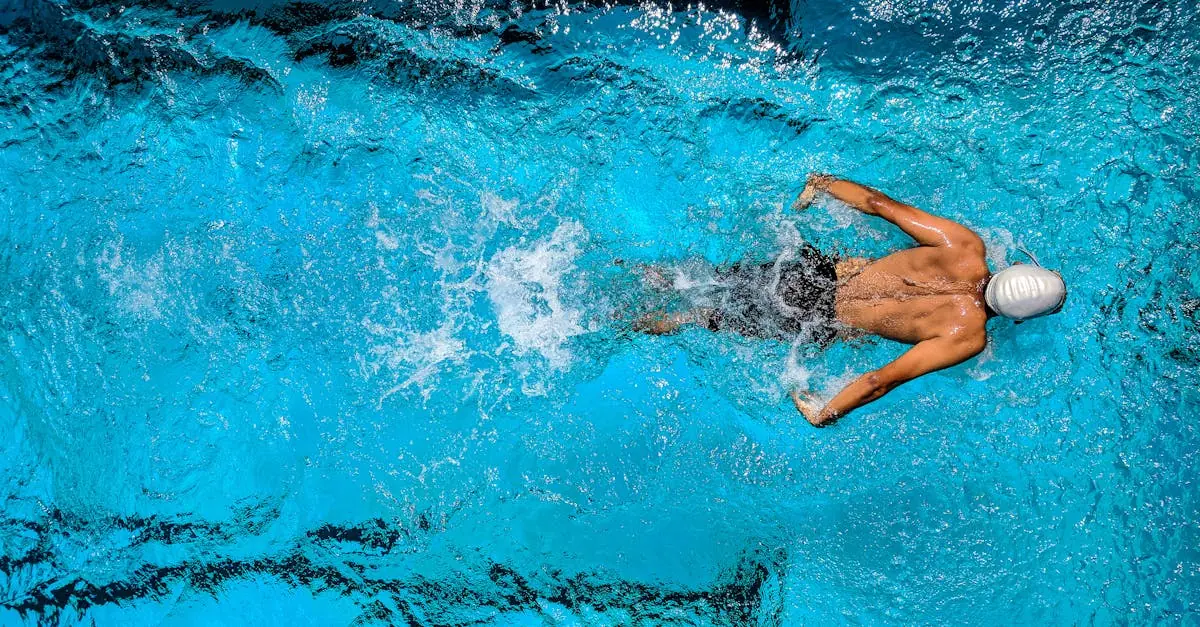Swimming isn’t just a way to cool off on a hot summer day; it’s a full-body workout that turns water into your best friend. Whether you’re perfecting your cannonball technique or channeling your inner Michael Phelps, there’s something magical about gliding through water. It’s the only time you can look like a graceful dolphin while simultaneously battling a rogue wave or a wayward pool noodle.
Table of Contents
ToggleBenefits Of Swimming
Swimming offers diverse advantages that contribute to overall well-being. It enhances both physical and mental health, making it a versatile activity for individuals of all ages.
Physical Health Improvements
Swimming provides significant cardiovascular benefits. Engaging in this full-body workout strengthens the heart and lungs. Increased muscle tone results from consistent practice, promoting lean muscle growth in various muscle groups. Joint health sees improvement due to the low-impact nature of swimming, reducing injury risk. Maintaining proper body weight becomes easier, with studies showing calorie burn rates up to 400-500 calories per hour, depending on the swimming style.
Mental Health Benefits
Mental health also benefits from regular swimming sessions. Research indicates that swimming can lower anxiety and depression levels. Endorphins released during physical activity create feelings of happiness and relaxation. Improved sleep quality often results from the calming effects of water, allowing for deeper rest. Building social connections through group swimming or clubs fosters a sense of community and belonging, further enhancing overall mental well-being.
Types Of Swimming
Swimming encompasses various styles and purposes, catering to different preferences and goals. Understanding these types enhances the swimming experience.
Competitive Swimming
Competitive swimming focuses on racing and achievements. Events often take place in organized meets, where swimmers compete in various strokes and distances. The four primary strokes include freestyle, backstroke, breaststroke, and butterfly. Training for competitive swimming involves structured workouts and techniques to improve speed and endurance. Athletes can burn significant calories, contributing to fitness levels and performance. Competitive swimmers aim for personal records and often participate in local, national, and international events.
Recreational Swimming
Recreational swimming emphasizes enjoyment and relaxation. It provides an opportunity for individuals to unwind while engaging in water activities. Options include swimming in pools, lakes, or oceans, with varying depths and temperatures. Family outings and social gatherings become a memorable experience through recreational swimming. Additionally, it serves as an effective way to build social connections and promote physical health. Non-competitive settings allow people to explore swimming skills or simply float and enjoy leisure time.
Essential Techniques For Swimming
Mastering essential swimming techniques contributes significantly to overall performance and enjoyment in the water. Focusing on the basics sharpens skills for swimmers of all levels.
Basic Swimming Strokes
Freestyle stands as the fastest and most popular stroke, emphasizing a streamlined position and alternating arm movements. Backstroke utilizes a backward position, providing a unique opportunity to breathe easily. Breaststroke relies on simultaneous arm movements and a frog-like kick, offering stability and rhythm. Butterfly requires coordinated arm sweeps and a powerful dolphin kick, showcasing strength and technique. Each stroke is essential for different swimming scenarios, whether for competition or recreation.
Breathing Techniques
Effective breathing techniques enhance endurance and efficiency while swimming. Swimmers should practice inhaling through the mouth during strokes, then exhaling through the nose underwater. Timing is crucial, meaning breath control aligns with arm movements for fluidity. Developing bilateral breathing in freestyle promotes balance and symmetry, making swimmers more versatile. Consistent practice of these techniques builds lung capacity, leading to improved performance and greater comfort in the water.
Swimming Safety Tips
Ensure safety while swimming by following these essential tips. Always swim in designated areas with lifeguards present. These personnel are trained to respond to emergencies and can provide immediate assistance. Never swim alone; buddy systems allow for enhanced safety and accountability. Checking water conditions before entering is crucial. Strong currents, waves, or a lack of visibility can pose significant risks.
Use appropriate swimming gear, such as life jackets for inexperienced swimmers. These devices provide extra buoyancy and help prevent accidents. Additionally, people should avoid swimming right after eating. Wait at least 30 minutes to reduce the risk of cramps.
Practice understanding your abilities in the water. Always stay within your skill level and avoid challenging environments without proper experience. Parents must supervise children closely, regardless of their swimming proficiency. Keeping a watchful eye ensures prompt response to any distress.
Be mindful of weather conditions. Lightning and thunderstorms can quickly turn a safe swimming environment into a dangerous one. In such cases, quickly exit the water and seek shelter. Lastly, educate swimmers about the signs of fatigue. Recognizing exhaustion helps avoid risky situations and promotes responsible swimming.
By adopting these safety measures, swimmers can enjoy the water while minimizing risks.
Conclusion
Swimming stands out as a versatile and enjoyable activity that caters to a wide range of preferences and goals. Whether diving into competitive races or leisurely floating in a pool, the benefits are undeniable. It not only enhances physical fitness but also boosts mental health, creating a holistic approach to well-being.
By mastering various techniques and prioritizing safety, individuals can maximize their swimming experience. Embracing this refreshing pursuit not only strengthens the body but also fosters connections with others. With its myriad advantages, swimming truly offers something for everyone, making it a cherished part of a healthy lifestyle.




